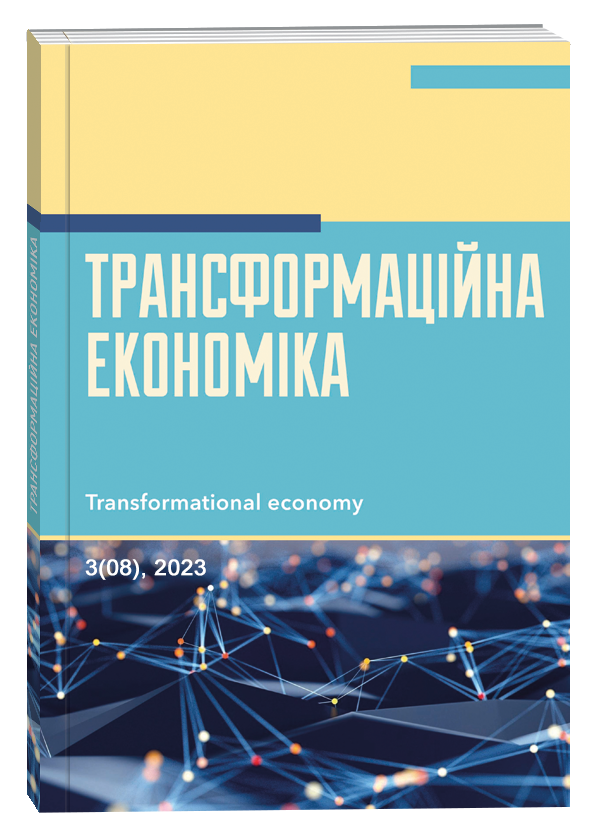THE LABOUR POTENTIAL OF AN ENTERPRISE AS A TOOL FOR ENSURING RESILIENCE TO BUSINESS RISKS
Abstract
The modern stage of economic development is characterized by increasing uncertainty, intensified competition, and growing socio-economic challenges, which requires special attention to the problem of entrepreneurial risk management. In this context, the labor potential of an enterprise becomes particularly important, as it is not only a set of professional and qualification characteristics of the workforce but also a strategic resource that ensures business resilience. High-quality labor potential contributes to reducing financial, organizational, socio-psychological, and innovation-related risks, while its underestimation or ineffective use increases the level of threats and complicates the stability of enterprise functioning. The aim of the study is to provide theoretical justification and practical disclosure of the role of labor potential in forming enterprise resilience to entrepreneurial risks, as well as to identify mechanisms for its integration into the risk management system. The study established that HR risks are an integral part of the overall risk management system and require specific approaches to identification and mitigation. The most common manifestations of HR risks include a shortage of qualified staff, high employee turnover, low levels of motivation and innovation activity, workplace conflicts, as well as a mismatch between employee competencies and the enterprise’s strategic objectives. Methods proposed for mitigating these risks include succession planning and the formation of a talent pool, the development of corporate culture, the implementation of flexible forms of employment, and the stimulation of professional development and participation in innovation projects. The scientific novelty of the study lies in substantiating the role of labor potential as a key factor in reducing entrepreneurial risks, as well as in proposing a system of key performance indicators (KPI) that make it possible to quantitatively assess the effectiveness of HR policy in the context of risk management. The practical significance of the research lies in the possibility of applying the proposed approaches by enterprises to develop integrated risk management strategies based on the development and preservation of labor potential. This ensures increased competitiveness, long-term stability, and business resilience in the conditions of dynamic transformations of the modern market.
References
Aven, T. (2021). Upravlinnia ryzykamy ta otsinka ryzykiv u skladnomu seredovyshchi [Risk management and risk assessment in complex environments]. Kyiv: Tsentr uchebnoi literatury, p. 312.
Gudzynskyi O. D. (2022). Ryzyk-menedzhment u systemi stratehichnoho upravlinnia pidpryiemstvom [Risk management in the system of strategic enterprise management]. Ekonomika i orhanizatsiia upravlinnia, vol. 1(49), pp. 24–30.
Kuzmin O. Ye., Savchenko I. H. (2023). Stratehichne upravlinnia promyslovym pidpryiemstvom v umovakh ryzykiv [Strategic management of an industrial enterprise under risk conditions]. Visnyk Lvivskoi politekhniky. Seriia: Menedzhment ta pidpryiemnytstvo v Ukraini, vol. 2(20), pp. 58–65.
Lipych L. V. (2021). Sotsialno-ekonomichna pryroda ryzykiv rozvytku pidpryiemstv u vidkrytykh systemakh [The socio-economic nature of enterprise development risks in open systems]. Naukovyi visnyk Mizhnarodnoho humanitarnoho universytetu, no. 48, pp. 72–76.
Shaulska L. V. (2022). Risk management as a basis of enterprise development strategy. Economics & Business, no. 5, pp. 41–46.
Kleindorfer P. R., Singhal K., Van Wassenhove L. N. (2005). Sustainable operations management. Production and Operations Management, vol. 14(4), pp. 482–492.
Simchi-Levi D., Schmidt W., Wei Y. (2014). Identifying risks and mitigating disruptions in the supply chain. Harvard Business Review, vol. 92(1/2), pp. 96–101.
Aven T. (2012). The risk concept – Historical and recent development trends. Reliability Engineering & System Safety, no. 99, pp. 33–44.
Hollnagel E. (2014). Proactive approaches to safety management. Journal of Contingencies and Crisis Management, vol. 22(1), pp. 40–42.
Lu Y., Xu X. (2019). A framework for risk-oriented smart manufacturing. Journal of Manufacturing Systems, no. 51, pp. 215–225.
Авен Т. Управління ризиками та оцінка ризиків у складному середовищі. Київ : Центр учбової літератури, 2021. 312 с.
Гудзинський О. Д. Ризик-менеджмент у системі стратегічного управління підприємством. Економіка і організація управління. 2022. №1(49). С. 24–30.
Кузьмін О. Є., Савченко І. Г. Стратегічне управління промисловим підприємством в умовах ризиків. Вісник Львівської політехніки. Серія: Менеджмент та підприємництво в Україні. 2023. №2(20). С. 58–65.
Ліпич Л. В. Соціально-економічна природа ризиків розвитку підприємств у відкритих системах. Науковий вісник Міжнародного гуманітарного університет. 2021. №48. С. 72–76.
Shaulska L. V. Risk management as a basis of enterprise development strategy. Economics & Business. 2022. No. 5. P. 41–46.
Kleindorfer P. R., Singhal K., Van Wassenhove L. N. Sustainable Operations Management. Production and Operations Management. 2005. Vol. 14(4). P. 482–492.
Simchi-Levi D., Schmidt W., Wei Y. Identifying Risks and Mitigating Disruptions in the Supply Chain. Harvard Business Review. 2014. Vol. 92(1/2). P. 96–101.
Aven T. The Risk Concept—Historical and Recent Development Trends. Reliability Engineering & System Safety. 2012. Vol. 99. P. 33–44.
Hollnagel E. Proactive approaches to safety management. Journal of Contingencies and Crisis Management. 2014. Vol. 22(1). P. 40–42.
Lu Y., Xu X. A framework for risk-oriented smart manufacturing. Journal of Manufacturing Systems. 2019. Vol. 51. P. 215–225.


